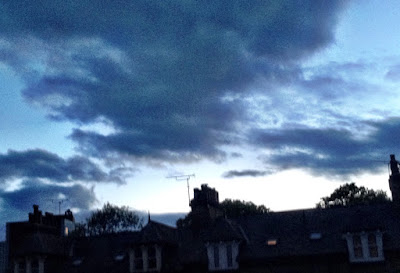I studied European history at University, but my particular interest lay in the cultural history of the dark to middle ages. Needless to say, aside from a course on the Art and Poetry of War, I didn't spend a lot of time studying either of the more recent World Wars.
Several friends of ours had very positive things to say about the Churchill War Rooms in central London, and since none of us had ever been there, we decided to give it a visit. The entrance fee is steep, even for London's prices, but it was an incredible experience and I think we were all glad we opted to pay the price of entry.
 |
| Signatures of Churchill, President Roosevelt, and several others |
I thought it would be a museum devoted to the life and times of Winston Churchill, the British Prime Minister during WWII. And don't get me wrong, it is certainly that — there's a gigantic room that houses everything you can imagine about the man — but it is actually the WWII bunker where he ran the war and finally stopped the Nazi's reign of communism, terror, and genocide.
The bunker is a block away from (and equidistant to) both the Houses of Parliament and #10 Downing Street, Britain's equivalent of the White House where the Prime Minister lives & works. It's about two stories below street level, and during WWII, Churchill, many of his commanding officers, and a handful of administrative staff (ladies) lived there, working around the clock, fighting Germany and its Nazi regime. Deep in the bunker they even worked through the Blitz, as above ground, the Luftwaffe tried to destroy London.
 |
| I loved this quote! |
The museum now within the war rooms tells of about the life and times of Winston Churchill, a very well born man whose extremely wealthy parents basically had him as something to do, and promptly handed him off to the nanny and never had much interaction with him. In an attempt to impress his father, Winston joined the military at a young age (wanting to end up in politics) and got himself captured fighting in the Boer War. He was a POW for a while, and then made an daredevil, solo escape in 1899 and became an instant celebrity back in the UK. In 1900, he was first elected as a conservative member of Parliament representing Oldham.
I know, boring stuff, but I thought it was fascinating!
 |
| One of the command rooms |
We walked past many rooms in the bunker, all of which, it is said, were left virtually untouched, just as they were on the last day of the war. Of course they put glass partitions up and, in a few instances, mannequines, but otherwise when the war ended, everyone left everything as is and closed the door, and that's how visitors see the war rooms.
Although we arrived fairly early, the corridors are very tiny and the windows into many of the rooms have limited viewing area and it gets crowded, fast. Therefore, I didn't take a lot of pictures of rooms such as the Cabinet Room, small offices, tiny communal bunk rooms (men's and women's), and an even tinier kitchen used by everyone living down there like mole people. But I did stop to take several pictures of the Map Room.
 |
| Map room with pins still in the same location as when WWII ended. |
The map room had maps with multi-colored pins, denoting the various troops, battle lines, submarines, bomb sights — honestly, there were so many different colored push pins I couldn't figure out what they all represented.
 |
| Up close of map in map room |
There were also lots of different colored phones, each one a secure line to someone very important, helping relay crucial information to the Prime Minister and his commanding officers.
The rooms were small, dark (no windows, obviously!), and dank - and on top of all that everyone smoked like a chimney back then, can you imagine?! Everyone working down in the bunker was issued a gas mask for the possibility of the Germans dropping poisonous gas bombs, but I would have wanted to use the gas mask to save myself from all the second hand smoke!
 |
| Different "Bat Phones" in the map room |
Sometimes when you go to an attraction or historical site that you knew nothing about, you are pleasantly surprised. And the Churchill War Rooms certainly was an unexpected high point during our short visit in London.
 |
| Map room, as it was left (with mannequins added) the day the war ended. |






























